The Best FPV Drones
The Top Racing Drones, Cinematic FPV Drones, and Freestyle Drones on the Market [New for 2024]
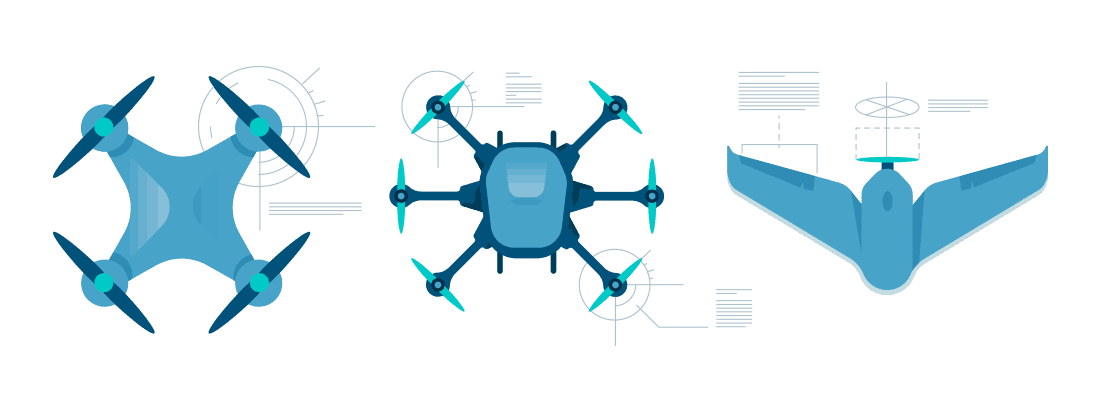
Note: Fly safely and responsibly, folks. Never flown before? Learn to fly for free over here. Need to get your FAA commercial drone certificate? Start studying over here.
This guide gives pilots a crash course on FPV drones. It includes sections on the three main types of FPV drones—racing drones, cinematic FPV drones, and freestyles drones—as well as our list of the top five ready-to-fly drones for FPV racing.
What Are FPV Drones?
Flying an FPV (first person view) drone is an otherworldly experience.
Before now, only in movies and video games could most people experience a bird’s-eye view while racing through obstacles at breakneck speeds. But thanks to FPV quadcopters, hexacopters, and other multirotors, anyone with enough flying skill to maneuver a drone can have this experience.
Want to jump around within this guide? Here’s a menu to the main sections:
Note: Because racing drones are some of the most popular FPV drones out there, we’ve devoted individual sections of this guide to our picks for the top five FPV racing drones on the market.
Here are links to each one in the guide in case you’d like to jump directly to see them:
- EMAX Hawk Pro FPV Drone
- Walkera F210 3D Edition Racing Drone
- APEX VR70 FPV Drone
- BETAFPV Cetus Pro FPV Drone
- The DJI FPV
Note #1: All specs/features are obtained from the manufacturer or retailer.
Note #2: On this list, we’ve included models available for sale on Amazon and DJI — as Amazon and DJI Associate partners, we earn a small commission for qualifying purchases. Please know that we’ve tested many of the models on this list, and we wouldn’t recommend anything we wouldn’t fly ourselves!
Drone Racing: A Competitive Sport and Exciting Hobby
Drone racing has grown rapidly as a competitive sport over the last several years. Leading the charge in that effort is the Drone Racing League, which has helped raise the sport from a hobby to a high-profile professional activity in the public eye.
Every year, the best racing drone pilots in the world compete in DRL events to make it to the top of the international rankings, and to win tens of thousands of dollars in prize money.
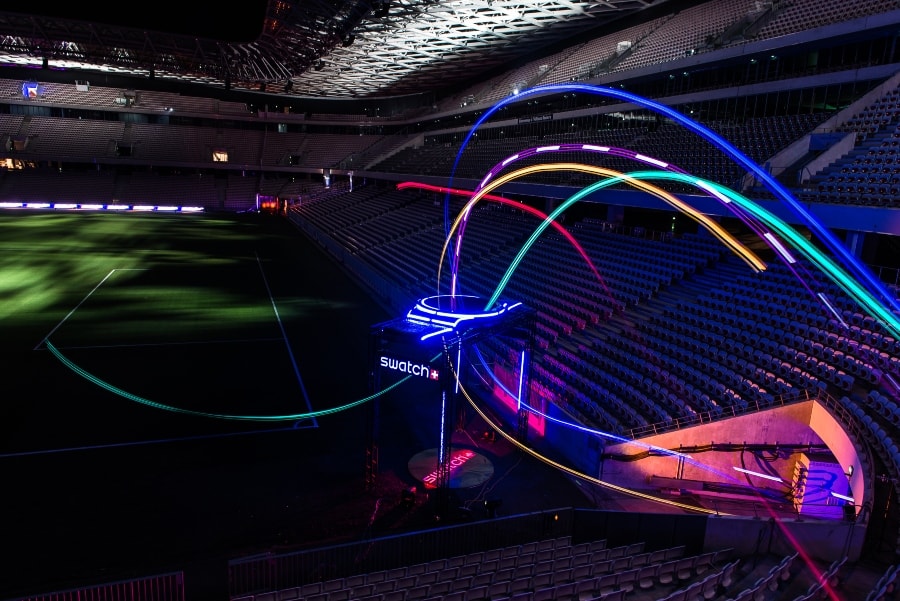
A drone racing track | Credit: DRL
Racing drones can fly up to 120 miles per hour (or faster) through hoops, around trees, over bars, and just about any object.
FPV drone race tracks are set up to challenge each pilot’s skill set. Professional tracks set up for sanctioned races can get extremely complex, requiring pilots to make acrobatic maneuvers to get around/through each obstacle. Many drone racing pilots also enjoy setting up their own courses using DIY racecourse kits.
How to Get Into FPV Drone Racing
If you’re interested in becoming a professional drone racing pilot, you need to practice, practice, practice!
An excellent way to develop your flight skills is to practice on a simulator, like the DRL Simulator. (See our list of top drone simulators for more options.)
You should also plug into the drone racing community. Look for local racing events in your area and join a drone racing group. Attending events as a spectator can help you learn more about the sport and may give you an opportunity to network with or seek mentorship from an experienced racing pilot.
Keep in mind, a lot of people race drones just for fun, and not because they have their sights set on going pro one day.
Want to get advice from a drone racing champion? Read our interview with Paul “Nurk” Nurkkala, former DRL Allianz World Champion.
Try Out for the Drone Racing League
One of the quickest—but also hardest—paths to a professional career as a drone racing pilot is by going through the DRL SIM Tryouts.
In the Tryouts, drone pilots compete on the DRL simulator. And the winner gets a real contract to be a professional drone racing pilot.
Here’s an overview of how the DRL SIM Tryouts work:
1. Qualifier Circuit. Drone pilots compete to set their fastest time in the DRL SIM and secure their spot with the 64 pilots that move to the next round.
2. Stage 1. After the Qualifier, the remaining pilots are winnowed down to a smaller group in four esports tournaments..
3. Stage 2. Two more esports tournaments further winnow the group of pilots, resulting in the finalists who will compete for the contract.
4. Grand Finale. A final race determines the winner!
Here are some links to help you learn more:
Drone Racing Leagues and Championships
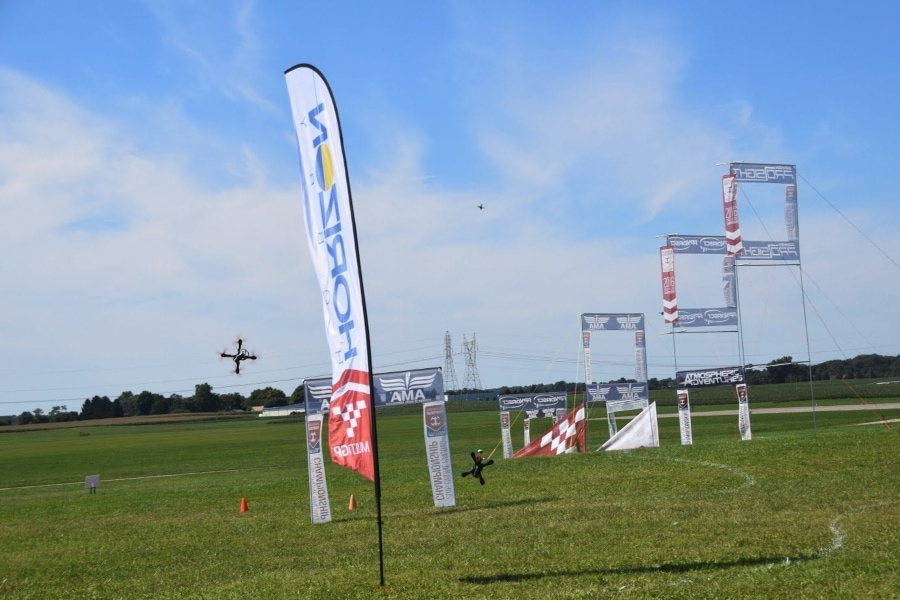

Credit: MultiGP Drone Racing League
- The Drone Racing League—The DRL is a global, professional drone racing circuit for elite pilots. The DRL season involves different races in which pilots accumulate points. Pilots with the highest number of points qualify for the World Championship.
- MultiGP Drone Racing League—With chapters all over the world and events and classes for all types of FPV racers, MultiGP is leading the way in FPV racing and event management.
- British Drone Racing Association—This group is a “Specialist Body” of the British Model Flying Association and provides racing opportunities via club programs and the British Drone Racing Championships.
Choosing the Right Type of FPV Racing Drone
Racing drones are very different from consumer camera drones used for shooting aerial photos and video, like the Mavic 3 Pro or the DJI Air 3.
Racing drones typically come in one of three setups:
1. Ready-to-fly (RTF)—Drones made for FPV racing that require no additional assembly.
2. Bind-and-fly (BNF)—Drones that come completely assembled, but without a controller.
3. Kits—Bundles of compatible components that require some assembly. May include the frame, motor, connecting parts, the controller, the transmitter, and/or other parts.
4. DIY racing drones—Pilots handpick all the components of their system and put them together to create a DIY, custom-built racing drone system.
If you’re interested in checking out drone racing kits, here is an example from DJI (additional parts are required with each kit/system):
For this guide, we’ll only be reviewing FPV drones that are already completely assembled.
Keep reading to see our list of the top five FPV racing drones on the market.
EMAX Hawk Pro FPV Drone

camera
1200 TVL

battery life
6-8 Min

good for
Beginner Racing Pilots
The EMAX Hawk Pro racing drone is tiny but powerful. Its large-capacity brushless motors combined with its small 8.2″ (210mm) size make the Hawk notably powerful.
Within its carbon fiber frame, this mini racing drone has a clean overlook and well-protected components. Unlike other mini drones, EMAX Hawk Pro has an attached mushroom antenna to provide a better signal.
The EMAX Hawk Pro is a great drone to start off with on your FPV racing journey. Before purchasing, know that this quad is BNF (bind and fly), meaning that you will need to buy a remote controller separately.
Features
- Carbon fiber frame
- One-button design to switch video output
- Pulsar brushless motor system
Specs
- Size. 8.2 inches (210 mm)
- Weight. .6 pounds (265 g)
- Camera. 1200 TVL
- Transmission. 5.8 G video transmission
- Flight time. 6 – 8 min
- Battery. 3S/4S Li-Po
Walkera F210 3D Edition Racing Drone

camera
700 TVL

battery life
8-9 Minutes

good for
Intermediate Racing Pilots
The Walkera F210 3D Edition has been one of the most popular ready-to-fly FPV drones on the market for years, and it’s a solid FPV racing drone at a modest price for serious racers.
This racing drone features an industrial, modular carbon fiber frame design that’s ultra-durable and crash-resistant.
Its flight control system enables stable flight and precise flight maneuvers like flips, rolls, and race course moves. The drone can also come to a quick stop and eliminate drift due to inertia, lowering collision risk.
The Walkera F210 is easy to disassemble and reassemble, which means it’s ready to fly as is, or can be customized by the pilot.
Features
- Carbon fiber frame
- Simple to assemble and disassemble
- HD night vision camera
Specs
- Size. 7.1 inches (182 mm)
- Weight. .8 pounds (370 g)
- Camera. 700 TVL
- Transmission. 5.8 G real-time image transmission
- Flight time. 8 – 9 minutes
- Battery. 4S Li-Po
APEX VR70 FPV Drone

camera
1080p

battery life
18 Min

good for
Beginner Racing Pilots
The APEX VR70 stands out in the FPV racing drone market as a budget-friendly option that doesn’t skimp on immersive flying experiences.
Designed with beginners in mind, the VR70 comes with FPV goggles that provide a super-wide 120° field of view, allowing pilots to feel as though they’re in the cockpit of the drone, enhancing the thrill of the race.
Despite being affordable, the APEX VR70 doesn’t fall short on performance. It’s equipped with low-latency 5.8G transmission, ensuring responsive and smooth control, which are crucial for navigating tight racecourses. Its durable design also makes it drop-resistant, offering peace of mind for new pilots concerned about the occasional crash.
Features
- Immersive FPV experience with included goggles
- Low-latency transmission for responsive control
- Durable and drop-resistant design
- Beginner-friendly manual flying capabilities
Specs
- Video Resolution. 1080p
- Weight. 066 pounds (30 Grams)
- Transmission. 5.8G Wi-Fi
- Flight time. Up to 18 min
- Dimensions. 3.54 x 3.54 x 1.57 inches
BETAFPV Cetus Pro FPV Drone

camera
SD Quality

battery life
3 Min

good for
Children and FPV Beginner Racing Pilots
The BETAFPV Cetus Pro is specially tailored for young enthusiasts and beginners venturing into the exhilarating world of FPV drone racing.
This compact drone comes as a complete kit, including a radio transmitter and FPV goggles, making it an ideal all-in-one starter package for the new FPV drone pilot.
One of the standout features of the Cetus Pro is its three distinct flight modes: Normal, Sport, and Manual. These modes allow pilots to progress at their own pace, starting with the basics and gradually moving up to full manual control. This versatility makes it an excellent platform for learning and mastering FPV flying skills.
Features
- Complete starter kit with drone, transmitter, and goggles
- Three adjustable flight modes for skill progression
- Advanced safety features including Altitude Hold and Emergency Landing
- Turtle Mode for easy recovery from crashes
Specs
- Weight. 1.62 pounds (735 grams)
- Battery capacity. 450 Milliamp hours
- Material. Durable plastic
- Dimensions. 10.24 x 8.66 x 5.12 inches
DJI FPV Drone

camera
4K, 60 fps

battery life
20 Minutes

good for
Intermediate/Advanced Racing Pilots
When it first launched, the DJI FPV drone created an entry point for FPV flying, allowing those who’d never flown FPV before to dive right in, without needing to build a custom racing drone or learn specialized piloting skills.
The drone comes with an optional Motion Controller, which redefines the flying experience by giving the pilot real-time control and feedback within a simple hand movement. Also, you can use “audience mode” that allow others with FPV goggles to watch your flight in real-time.
And the DJI FPV isn’t just for racing. Its hybrid design makes it great for drone racing, cinematic flying, and freestyle flying, which we’ll cover in more detail in the following sections.
Other flight modes you can use with the DJI FPV include:
- N mode for new users
- M mode for manual FPV racing
- S mode for capturing cinematic FPV footage
Features
- Ocusync 3.0 allows for a 6.2-mile transmission range
- Color-changing front LED’s
- 150° FOV
- Auxiliary bottom light
- Obstacle sensing
- DJI AirSense (ADS-B receiver alerts you of nearby manned aircraft)
Specs
- Size. 9.6 inches (245 mm)
- Weight. 1.8 pounds (795 g)
- Camera. 4K at 60 fps
- Flight time. 20 minutes
Cinematic FPV Drones
Cinematic FPV drones represent a groundbreaking evolution in aerial photography and videography, merging the immersive perspective of FPV flying with the capability to capture breathtaking, high-quality cinematic footage.
Unlike their drone racing counterparts, which are built for speed, agility, and competition, cinematic FPV drones are designed with stability, camera quality, and smooth flight dynamics in mind, making them ideal for capturing stunning aerial shots that were once only possible with larger, more cumbersome equipment.
Check out this cinematic FPV tour of Venice:


Watch this video on YouTube
High-quality cinematic FPV drones have made it possible for filmmakers, content creators, and hobbyists to achieve dynamic shots that swoop through tight spaces, elegantly trace fast-moving subjects, and glide smoothly over breathtaking landscapes, all while maintaining a high level of control and precision.
But not all cinematic FPV drone shots are of serene landscapes or ancient cities.
Increasingly, action movies have been featuring cinematic FPV footage, leveraging the high speeds and cinematic quality these drones can capture to get footage like that featured below, which was shot by Johnny FPV.


Watch this video on YouTube
Cinewhoops vs. Cinematic FPV Drones
Cinewhoops are a specialized subset of cinematic FPV drones, designed specifically for capturing high-quality, stabilized footage in challenging environments where traditional drones might not be as effective.
These are the drones used in the fly through tours of venues as diverse as stadiums, restaurants, and concert halls over the last few years.
Cinewhoops are characterized by their smaller size, ducted propellers for increased safety (allowing them to fly closely to subjects and through tight spaces), and the ability to carry high-quality cameras for cinematic purposes.
Here’s Right Up Our Alley, one of the most iconic cinewhoops of all time:


Watch this video on YouTube
The Best Cinematic FPV Drones on the Market
Here’s a list of our picks for the top cinematic FPV drones on the market, including a few cinewhoops.
1. The DJI Avata
Known for its immersive FPV 4K/60p recording capabilities, the DJI Avata is DJI’s first ever cinewhoop, and a top pick for capturing action footage or making fly through tours.
The Avata is designed to pair seamlessly with the DJI FPV Goggles V2 and the DJI Motion Controller, offering an enhanced, immersive flying and filming experience. Its agility and precision make it suitable for capturing both intense action sequences and mesmerizing aerial shots.
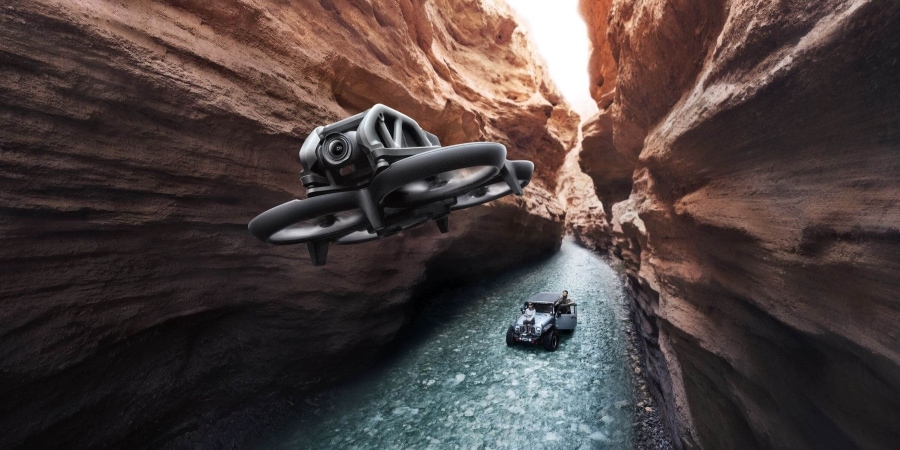

Credit: DJI
Thanks to its user-friendly setup, the Avata is perfect for both novice and seasoned pilots. Its agility and precision, combined with a super-wide 155° FOV, make it ideal for sweeping landscapes and tight urban spaces alike.
Features
- Immersive FPV experience with 4K/60p recording
- Advanced stabilization with RockSteady and HorizonSteady
- DJI Motion Controller for intuitive flight controls
- Super-wide 155° field of view for expansive shots
Specs
- Transmission distance. Up to 6.2 mi (10 km)
- Camera resolution. 4K/60p
- Flight time. Up to 18 min
Learn more about the DJI Avata.
2. The GEPRC CineLog35 HD
The GEPRC CineLog35 HD is a game-changer for cinematographers looking for a highly customizable FPV drone.
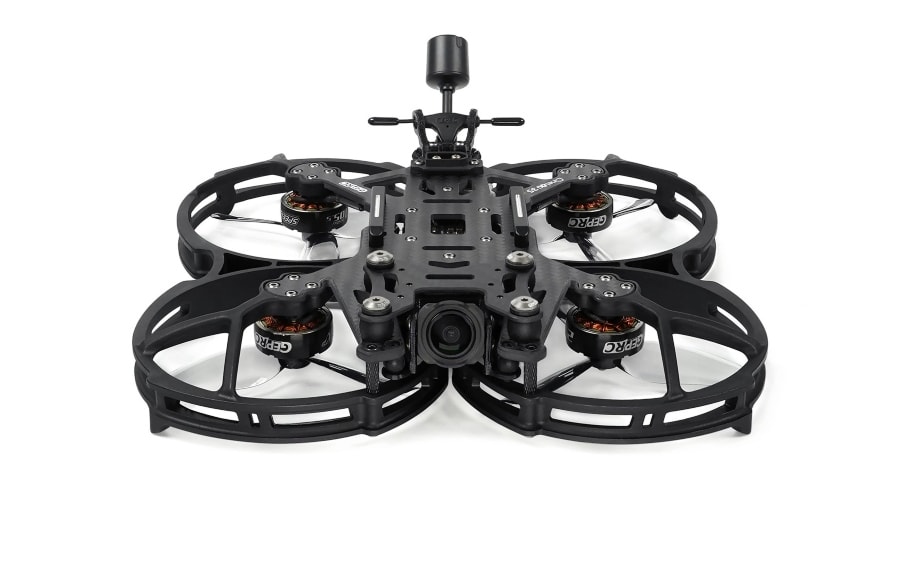

Unlike drones with fixed cameras, the CineLog35 HD allows you to mount a variety of action cameras such as the GoPro HERO9 Black, GoPro HERO10 Black, and Insta360 GO 2, offering the flexibility to choose your preferred camera for the job.
The CineLog35 HD also stands out for its durable construction, complete with prop protection guards, ensuring it can withstand the rigors of dynamic filmmaking.
Features
- Customizable with various action cameras for flexible recording
- Durable construction with propeller protection guards
- Compatible with multiple FPV goggles
- Stable flight performance for high-quality footage
Specs
- Flight time. Up to 12 min
- Weight. Not specified
- Camera compatibility. Action cams like GoPro HERO9/10 Black, Insta360 GO 2
- Transmission. Compatible with various FPV systems
Learn more about the GEPRC CineLog35 HD.
3. The BetaFPV Pavo20 Whoop FPV Drone
The BetaFPV Pavo30 Whoop represents a leap in the CineWhoop category, setting itself apart with its small size and compatibility with the DJI O3 system, which allows for 4K HD video capture.
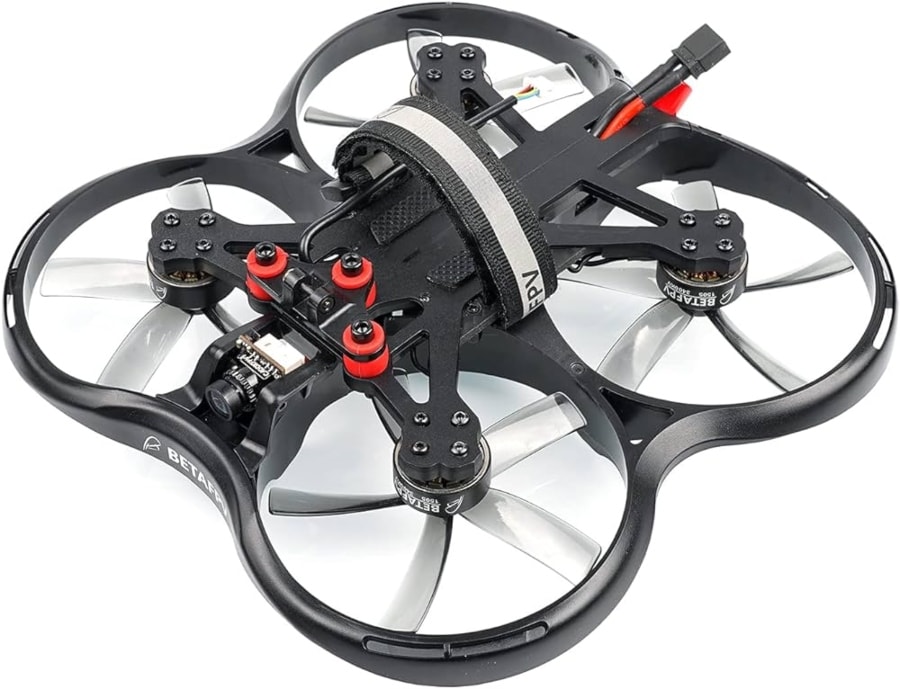

Designed with indoor flying in mind, the Pavo30 excels in tight spaces where its excellent handling capabilities shine. Its compact size not only makes it less obtrusive but also safer for flying in close proximity to people and property, minimizing risk while capturing intimate shots.
Features
- Compact and unobtrusive design ideal for indoor flying
- Compatible with DJI O3 for high-quality 4K video capture
- Excellent handling capabilities for tight spaces
- DIY assembly for a personalized flying experience
Specs
- Flight time. Up to 5 minutes
- Weight. Under .33 pounds (150 g)
- Camera compatibility. DJI O3 system
- Flight conditions. Optimized for indoor use
Learn more about the BetaFPV Pavo20 Whoop.
4. The Flywoo CineRace20 FPV Drone
The Flywoo CineRace20 is a compact, versatile 2-inch CineWhoop that’s engineered for both indoor and outdoor cinematic flights.
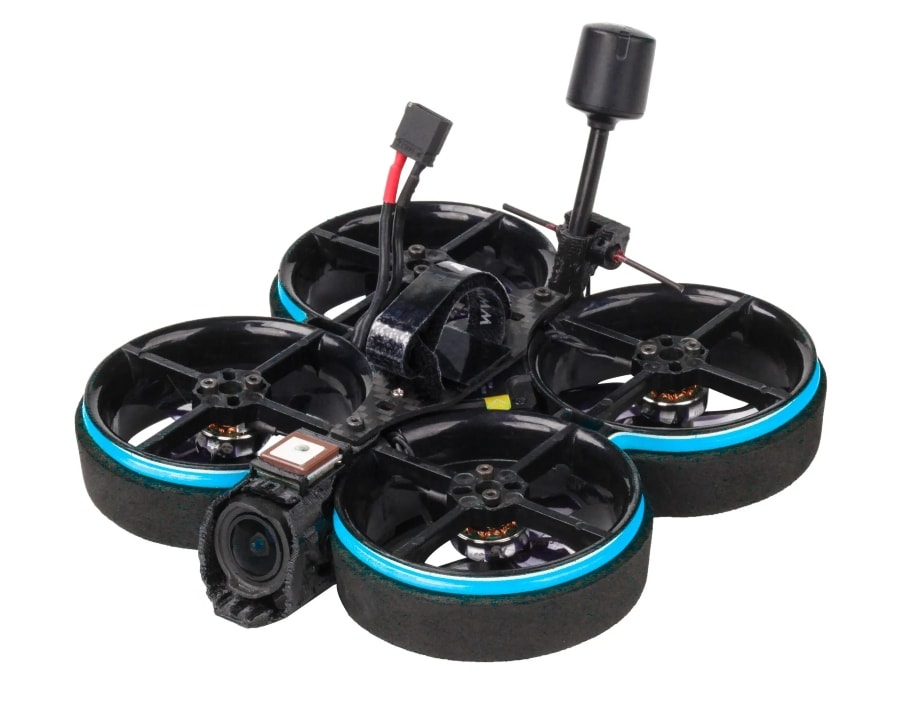

Equipped with the DJI O3 Air Unit, the CineRace20 can capture high-quality footage directly without the need for bulky external cameras. Despite its small size, the drone does not compromise on durability, featuring a robust design that can withstand the demands of dynamic flying.
However, it’s worth noting that the CineRace20 may produce louder noise levels during flight and could experience yaw washout during extreme maneuvers.
Features
- Compact and durable design suitable for indoor and outdoor use
- DJI O3 Air Unit for direct high-quality video capture
- Extended flight time for more comprehensive shooting sessions
- Stable and jello-free flight performance
Specs
- Weight. .48 pounds (220 grams) with 4S 750mAh battery
- Flight time. 7-8 min
- Camera. DJI O3 Air Unit
- Compatibility. Indoor and outdoor flights
Freestyle FPV Drones
Freestyle FPV flying is an art form that combines creativity, technical skill, and style, allowing pilots to express themselves uniquely in the skies.
Freestyle flying differs from racing in its focus on acrobatics, flow, and the aesthetic presentation of flight rather than speed and competition.
Here’s an FPV freestyle video shot by YouTuber Mr. Steele:


Watch this video on YouTube
The Top Freestyle FPV Drone YouTube Accounts
Freestyle flying is incredibly fun to watch—and there are some truly incredible YouTube accounts out there sharing some of the most impressive FPV freestyle you can find.
Here are some of our favorite accounts sharing freestyle flying videos.
1. Rotor Riot
Rotor Riot is a weekly YouTube show featuring the world’s most talented and interesting FPV pilots. We post new episodes every week and sometimes more! We are known for celebrating FPV Lifestyle by pushing the limits and showcasing the capabilities of FPV Freestyle.


Watch this video on YouTube
2. Captain Vanover
2019 DRL world champion, Professional drone pilot.


Watch this video on YouTube
3. Johnny FPV
FPV cinematography.


Watch this video on YouTube
4. Mr. Steele
Traveling the world, meeting new people, and sharing my experiences through the eyes of my 70+MPH Drones


Watch this video on YouTube
The Best Freestyle FPV Drones on the Market
Here’s a list of our picks for the top freestyle drones out there.
1. The GEPRC MARK5 HD Vista FPV Drone
The GEPRC MARK5 HD Vista is built for the freestyle FPV pilot who demands both style and substance. Its wide X-arm design and unique shock-absorbing structure minimize vibrations for a stable flight experience, essential for high-quality footage.
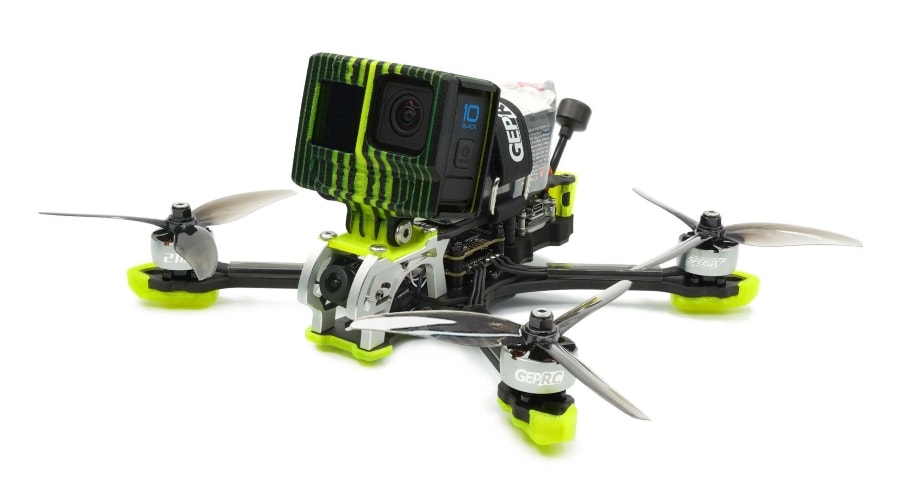

The GEPRC is powered by robust 2107.5 motors, providing explosive power and rapid responsiveness. It comes ready to accommodate various action cameras, offering flexibility in capturing cinematic shots.
Features
- Wide X-arm design for stability
- Shock-absorbing structure for smooth flights
- Compatible with various action cameras
Specs
- Motors. GEPRC 2107.5
- Flight controller. SPAN F722-BT-HD V2
- Camera compatibility. Various action cameras
Learn more about the GEPRC MARK5.
2. The iFlight Nazgul5 V2 FPV Drone
The iFlight Nazgul5 V2 stands out in the freestyle FPV arena with its robust build and high-performance capabilities. Designed for versatility, it accommodates a range of HD cameras, allowing pilots to capture stunning aerial footage.
The Nazgul5 V2’s frame and powerful motors make it a favorite among intermediate to advanced pilots seeking a reliable and agile drone for dynamic freestyle maneuvers and cinematic shots.
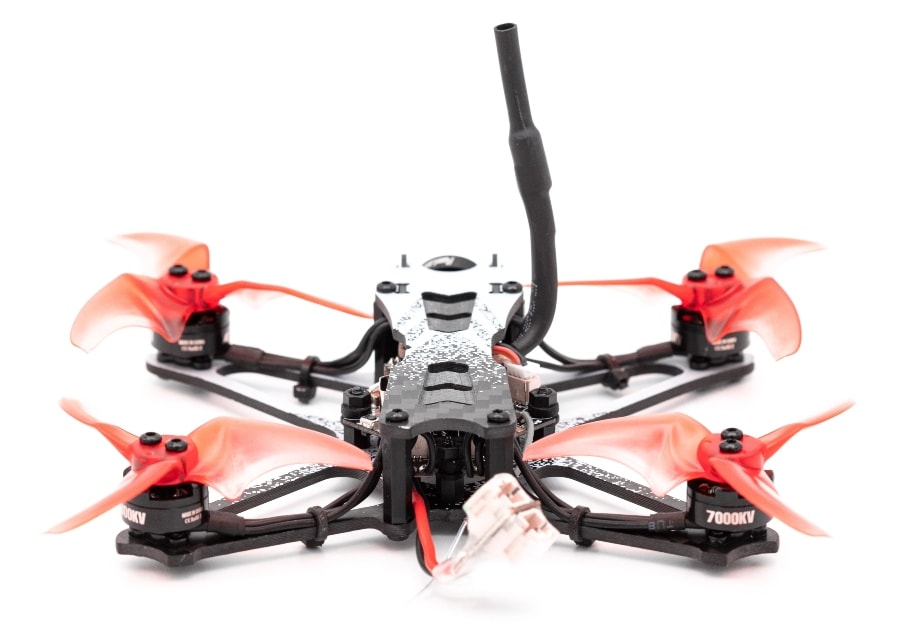

Features
- Durable build for freestyle acrobatics
- Compatible with a variety of HD cameras
Specs
- Weight. .88 pounds (399 g)
- Frame. Durable and robust design
- Motors. High-performance for agility
- Camera compatibility. Various HD options
Learn more about the iFlight Nazgul5 V2.
3. The EMAX Tinyhawk II Freestyle FPV Drone
The EMAX Tinyhawk II Freestyle is a nimble and resilient drone designed for thrilling FPV freestyle flying. Its compact form factor is complemented by robust brushless motors, making it an ideal choice for pilots seeking a blend of speed and maneuverability.
The Tinyhawk II’s durable frame and high-quality camera offer a reliable and immersive flying experience, suitable for a range of skill levels. And its BNF configuration allows for quick setup with your existing transmitter, making it a convenient option for those eager to fly without extensive assembly.
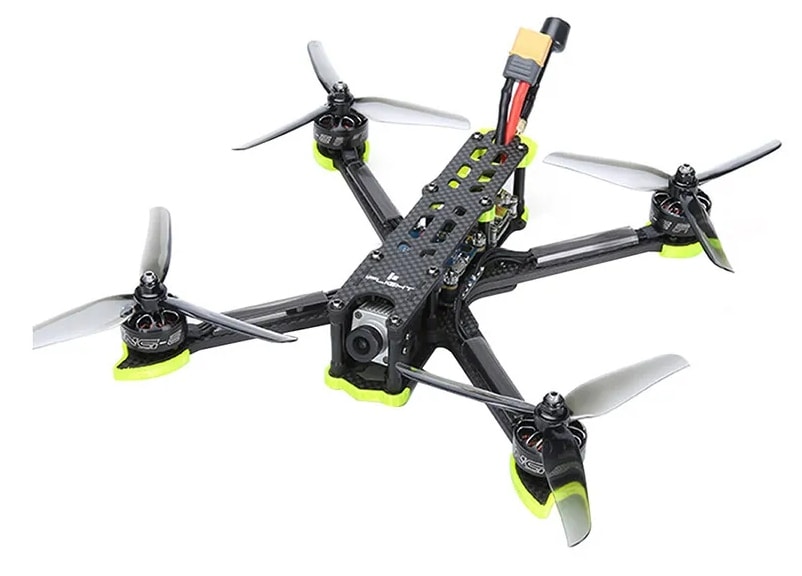

Features
- Durable frame for resilience against impacts
- High-quality camera for clear FPV feed
Specs
- Weight. .17 pounds (79 g)
- Camera. RunCam Nano2 700TVL
- Flight time. About 4 min
Glossary
FPV (first person view): Using a screen, monitor, or goggles to view what your multirotor’s camera is seeing in real time.
Line of Sight (LoS): Being able to physically see your drone as you’re piloting it.
FPV racing: A rapidly growing sport in which pilots race small quadcopters around a predetermined track.
RTF (ready to fly) racing drones: Drones made for FPV racing that require no additional assembly.
DIY racing drones: A homemade do-it-yourself racing drone.
FPV camera: A special camera used for first-person-view racing, piloting, photography, or videography.
FPV goggles: A special set of goggles used to view what the multirotor’s camera is seeing in real time.
Head tracking: An FPV goggle mod that allows you to adjust your camera’s angle mid-flight by tilting your head.
Interpupillary distance: Internal goggle lens distance from the center of your pupils.
LCD monitor: A screen, usually attached to the controller, used to view what a multirotor’s camera is seeing. Usually used instead of goggles.
Transmitter: Relays the camera’s feed to the receiver.
Receiver: Accepts the camera’s feed and relays it to your screen/goggles of choice.
Frequency: The radio frequency FPV equipment runs on. Can be brand-dependent. Allows for multiple channels so pilots don’t interfere with each other.
FPV system: The entire drone rig, from the multirotor itself, to the connecting parts, to the controller and video display method.
On Screen Display (OSD): Gives you flight telemetry data (speed, altitude, battery life, etc) on your FPV display. See a full OSD guide here.
TVL (Resolution): The camera’s resolution, which helps determine video feed quality and clarity.
CCD camera type: Camera that uses a charge-coupled device (CCD) image sensor. Typically better for FPV.
CMOS camera type: Camera that uses a complementary metal–oxide–semiconductor (CMOS) image sensor. Typically cheaper than CCD cameras, but not as good for FPV.
Video Latency: Lag in what your camera sees and when it transmits it to your screen/goggles. Can lead to inaccurate flight, racing maneuvers, and aerial shots.
Jello: Vibration in your video caused by the multirotor itself.


